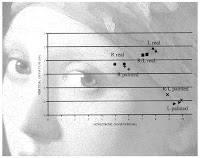
Do you have a favorite art piece done by an artist in the past or present? Do you have your least favorites too? It's only normal to judge something based on your likes and dislikes...especially with Art.
I don't know about you, but when it comes to art; I have my favorites and my least favorites. Except for this one specific art piece, "Girl with a Pearl Earring." To me, I believe this is one of the most fascinating paintings done by Johannes Vermeer and it is a piece that is famous for its mysterious context filled with many secrets.

In the original painting created by Johannes Vermeer, the painting was an oil on an 18 ¼ X 15 ¾ inches (46 ½ X 40 cm.) canvas. It has been said to be the painting of either Vermeer’s wife, Maria de Knuijt or his daughter, Magdelena van Ruijven, but there is no evidence to prove either possibilities to who the girl is in the painting (Russell, 2009).
This is one of the mysterious secrets to this painting, which makes me want to know who the girl really is in the painting. If she is even related to a story about Johannes Vermeer that no one knows at all or some secret just waiting to be found. In relation to my urge of finding out who the girl is, a fiction novel was even published in 1999, written by Tracy Chevalier, called "Girl with a Pearl Earring." This novel is based off of Johannes Vermeer's life and the famous painting which happens to be a household maid, who becomes a model for the Dutch artist in the 17th century.

In most of Vermeer’s paintings, his mature domestic genre pieces, like the “Girl with a Pearl Earring,” have a characteristic pearly light. The eye is drawn into the picture by the careful placing of objects and a clearly defined architectural space.
In the Journal of Psychology in July of 2007, ten observers viewed Vermeer’s painting, “Girl with a Pearl Earring,” and estimated her direction of gaze when her eyes were exposed together and separately. The observers also viewed the painting when her eyes were digitally replaced by those of a real person. It is believed that Vermeer painted the girl’s eyes with a precision that was near the limits of acuity. Vermeer included three gaze illusions, none of which researchers have documented during his time: (a) when a model whose head is turned to one side gazes at an observer, there is an illusion that she is looking to the side of the observer away from the direction of her head turn; (b) when a model’s eyes are viewed separately, they appear to gaze outward relative to each other; and (c) when both of a model’s eyes are viewed, the perceived direction of gaze follows that of the nearer eye (West, 2007).

Image Caption:Four examples are selected from the total of 24 images used: (A) Both eyes are painted and both Purkinje images are present; (B) Both eyes are real and both Purkinje images are present; (C) The right eye is painted but the Purkinje image is absent, and the left eye is blacked out; and (D) The head is flipped right to left, the originally left eye is real with the Purkinje image present, and the originally right eye is blacked out. (West, 2007)

Image Caption:Graph of the distances of the perceived directions of gaze from the center of the peephole at the plane of the observer's face. The graph is superimposed on the girl's face to give a direct comparison with the facial dimensions. The two symbols in each labeled pair represent the Purkinje images present and no Purkinje images conditions. For all symbol pairs, the symbol closest to the peephole (x = 0) corresponds to the Purkinje images present condition, but the separations between symbol pairs are very close and are not statistically significant. (West, 2007)
This goes to show that even though Vermeer may have not known at the time; he created an art piece that had a deeper psychological meaning. How amazing is that, not bad for an artist back in the time; creating something in relation to structural mathematical adjustments of the positions of items in the painting. In relation to view and sight, a recent artist named Devorah Sperber, points this out as well in her rendition of the "Girl with a Pearl Earring" art piece called, "After Vermeer II."


Works Cited:
Russell, I. Jon. “Art Commentary.” Journal of Musculoskeletal Pain 17.3 (2009): 217-220. Academic Search Premier. EBSCO. Web. 7 Oct. 2009.
West, Roger W., and Hank G. Van Veen. “Gaze as Depicted in Vermeer’s Girl With a Pearl Earring. “Journal of General Psychology 134, no. 3 (July 2007): 313-328. Academic Search Premier. EBSCO. Web. 7 Oct. 2009.

No comments:
Post a Comment